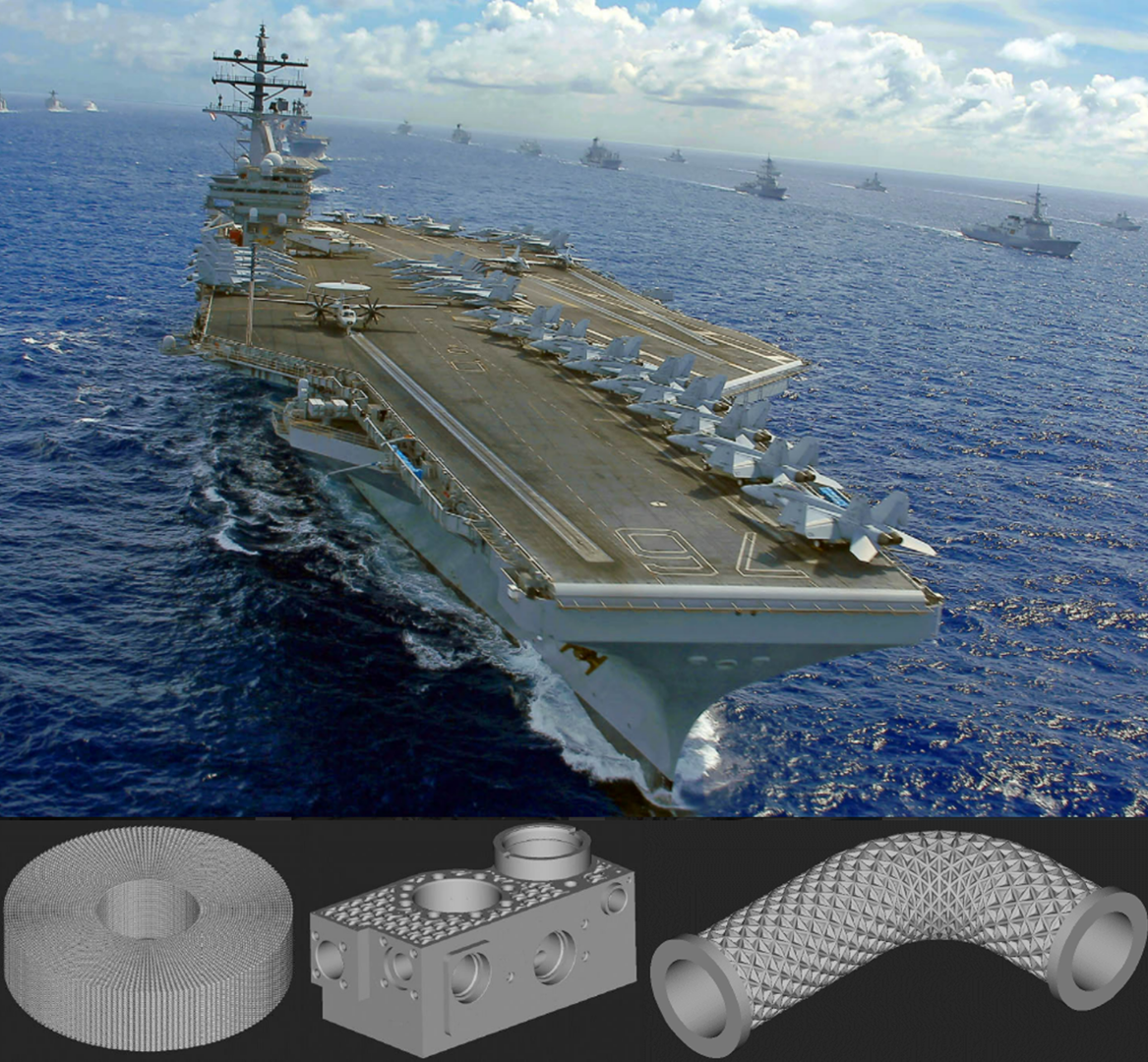


Marotta Controls designs, develops, manufactures and qualifies high-performance motion and flow control solutions for surface ships, submarines, and deep submergence vessels.
Problem
Marotta designs for Naval components were developed using traditional CAD models and manufacturing techniques. Additive manufacturing (AM) designs offered the potential to improve performance and manufacturability over traditional CAD tools. For example, AM designs offered a unique ability to consolidate parts that otherwise required low-yield brazing operations. Additional data was necessary to assess AM design and performance trade-off risks. Acceptance of these marine application AM designs required further evaluation of lattice and triply periodic minimal surface (TPMS) structure tensile properties. Critical performance relationships between lattice structure geometry and mass distribution were not well understood. Additional analysis of as-built geometry, tolerancing, and surface condition was necessary to understand the acceptance of AM designs. Without this information, qualification and acceptance of these novel designs faced significant delays to a successful transition.
Objective
The project quantitatively evaluated relationships between novel AM-enabled design features and effects on product tolerancing, manufacturability, mechanical performance, and flow performance. The goal of the systematic iterative design analysis was to improve product flow performance while maintaining mechanical performance and limiting reliance on low-yield manufacturing operations such as brazing. The approach assessed and documented design limits, design methods, and testing methods necessary for accelerating the qualification and acceptance of these components for naval marine applications.
Technical Approach
The technical approach of this project included three focus areas: evaluating AM product design to reduce flow noise, evaluating AM filter as-built quality for assembly consolidation, and AM material mechanical performance. A series of lattice and TPMS design features including unit cell size, wall thickness, and wall bias was correlated to flow diameter, flow path volume, and flow rate. Sub-scale flow coupon manufacturing was used to assess and analyze nominal vs. as-built geometric tolerancing, and minimum feature sizes, and refine product design methods. In addition, computational fluid dynamics (CFD) analysis was used for flow testing artifacts to quantify flow performance. Various as-built mesh geometries and surface conditions were evaluated to understand consolidated filter assembly quality. Tensile testing of 17-4 PH lattice and TPMS structures produced using laser powder bed fusion provided the baseline mechanical performance necessary to qualify the AM design material and AM process. Noise testing included airborne and structure-borne noise using flow testing artifacts. The approach delivered novel test geometries, validated testing methods and data, as well as documented analysis of the structural and material performance, and associated lessons learned that link material, structure, processing, and performance relevant to Naval marine applications.
Accomplishments
A design and manufacturing process was successfully developed for AM filters which accomplished the objectives of improving the AM print resolution for thin filter walls and small apertures by means of filter design, file export, and laser path control. The method of designing the filter walls as two sets of unidirectional walls and exporting those objects as a zero-thickness open mesh was highly effective in controlling the AM laser path to yield the thin walls and small apertures. The current design of the components is highly robust, as revealed by cycle testing, as no damage occurred during testing. The functions of the three elements from the traditionally manufactured component (body, screen, and plug) were successfully combined into a single monolithic model. This effort provided sufficient proof of concept for this AM filter design and manufacturing methodology. The potential of this AM filter concept is promising as there are many avenues to improve performance in future work.
The lattice tensile specimen design was successful. The gauge size supported a wide range of unit cell sizes and pointed toward a potential critical ratio of the unit cell to gauge dimension ratio to yield accurate metamaterial data. The grip design resulted in no abnormal failures. Also, the blended grip to gauge transition successfully removed stress concentrations at the grip and gauge interface. 100% of the specimens demonstrated fracture initiations within the central gauge region, indicating valid test results. The DIC data provided high-accuracy displacement data which is important to advancing lattice structure design methods.
The evaluation of implicitly modeled features on small flow channel components was also successful. The designing of flow elements with a gradual increase in the nominal flow passage diameter resulted in predictable outcomes. The diamond unit cell-based flow paths were found to have relatively high print consistency because all flow paths are oriented at an angle.
Project Participants
Project Principal

Other Project Participants
- HARBEC
- The Ohio State University
Public Participants
- U.S. Department of Defense
